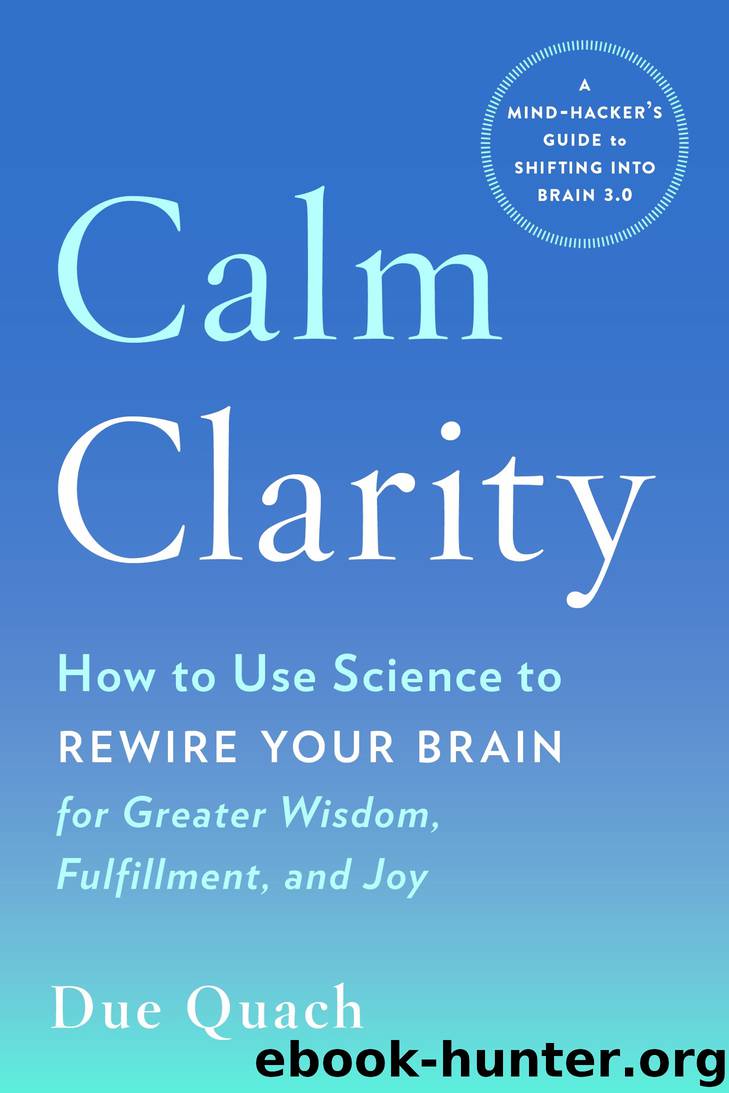Calm Clarity by Due Quach

Author:Due Quach
Language: eng
Format: epub
Publisher: Penguin Publishing Group
Published: 2018-05-15T04:00:00+00:00
Building Calm Clarity
The journey of building Calm Clarity involved several major interconnected streams: my ongoing inner transformation and deepening understanding of the convergence between science and spirituality, supporting people as individuals to steadily shift from Brain 1.0 and Brain 2.0 into Brain 3.0 in many different aspects of their lives, and collaborating with institutions such as businesses, nonprofit organizations, and schools in order to nurture and cultivate Brain 3.0 among larger groups and change their culture to be more in line with activating and sustaining Brain 3.0 (rather than Brain 1.0 or Brain 2.0).
After the vision came to me, I got started by taking the most logical first step. I reviewed the science-based books and articles that I had found most inspiring and insightful. Then I used their citations and references to compile and track experts whose studies were relevant to understanding and explaining how to direct brain development toward enhanced well-being and effectiveness. I read the books that those experts wrote, watched the TED Talks and other lectures they gave on YouTube, followed mass media articles and blog posts announcing findings from their latest studies, and then tracked the experts that they cited, and so forth. As I compiled the research, key themes emerged that enabled me to connect the findings to various essential life skills.
Compiling the research on meditation led me to make the practice of “metta” (often translated as compassion or loving-kindness) meditation a cornerstone technique thanks to recent studies on its benefits and potential to reduce the physiological effects of toxic stress and trauma. Earlier in 2013, David Kearney at the University of Washington School of Medicine had published the results of a pilot study that involved training veterans with post-traumatic stress disorder to practice metta meditation for twelve weeks, which concluded, “Overall, loving-kindness meditation appeared safe and acceptable and was associated with reduced symptoms of PTSD and depression.”3 In addition, research led by Barbara Fredrickson at the University of North Carolina at Chapel Hill found that metta meditation led to an increase in positive emotions, enhanced social connection, and improved the functioning of the vagus nerve.4 In parallel, Cendri Hutcherson, Emma Seppälä, and James Gross at Stanford found that even just a few minutes of metta meditation led to increased feelings of social connection and positivity toward meeting new people.5
Investigating further, I learned that vagus nerve activity and social connection are associated with oxytocin, a natural chemical circulating in the human body and brain that got nicknamed the “cuddle hormone” because hugging someone is linked to the release of oxytocin from the pituitary gland, although it is not exclusive to cuddling. Increases in oxytocin are linked to a wide range of affectionate physical gestures, including holding someone’s hand and petting a dog or cat. Oxytocin also gets released when we fawn over cute babies and watch adorable animal pictures and videos on the Internet. This is significant because higher levels of oxytocin are associated with enhanced trust and feelings of connectedness, prosocial behavior and cooperation, and higher resilience to stressors.
Download
This site does not store any files on its server. We only index and link to content provided by other sites. Please contact the content providers to delete copyright contents if any and email us, we'll remove relevant links or contents immediately.
The Compound Effect by Darren Hardy(8869)
Tools of Titans by Timothy Ferriss(8303)
Nudge - Improving Decisions about Health, Wealth, and Happiness by Thaler Sunstein(7654)
Win Bigly by Scott Adams(7133)
Deep Work by Cal Newport(6961)
Rich Dad Poor Dad by Robert T. Kiyosaki(6506)
Principles: Life and Work by Ray Dalio(6296)
Pioneering Portfolio Management by David F. Swensen(6253)
The Barefoot Investor by Scott Pape(5718)
Digital Minimalism by Cal Newport;(5700)
Grit by Angela Duckworth(5553)
The Slight Edge by Jeff Olson(5376)
Discipline Equals Freedom by Jocko Willink(5333)
The Motivation Myth by Jeff Haden(5174)
You Are a Badass at Making Money by Jen Sincero(4891)
The Four Tendencies by Gretchen Rubin(4575)
Eat That Frog! by Brian Tracy(4479)
The Confidence Code by Katty Kay(4217)
Bullshit Jobs by David Graeber(4136)
